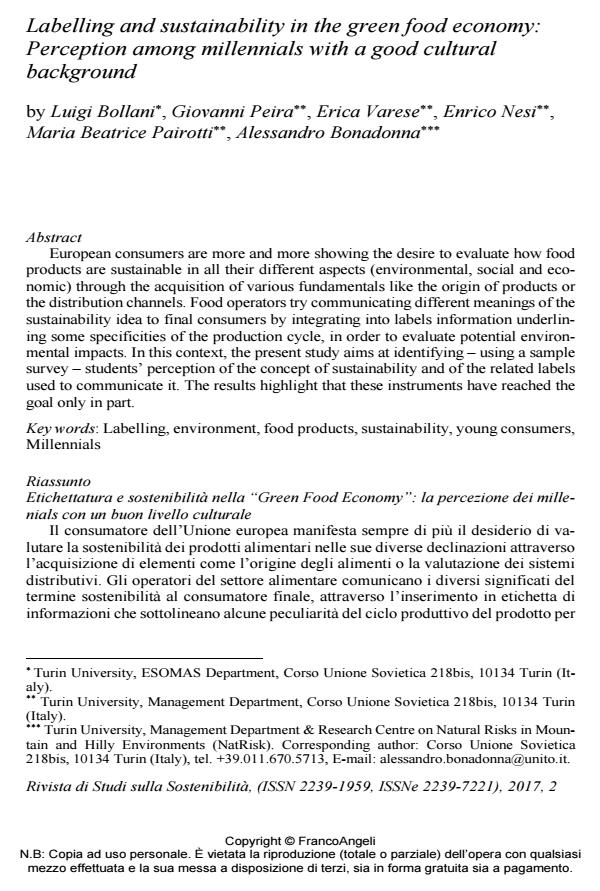Labelling and sustainability in the green food economy: Perception among millennials with a good cultural background
Titolo Rivista RIVISTA DI STUDI SULLA SOSTENIBILITA'
Autori/Curatori Luigi Bollani, Giovanni Peira, Erica Varese, Enrico Nesi, Maria Beatrice Pairotti, Alessandro Bonadonna
Anno di pubblicazione 2017 Fascicolo 2017/2
Lingua Inglese Numero pagine 19 P. 83-101 Dimensione file 249 KB
DOI 10.3280/RISS2017-002007
Il DOI è il codice a barre della proprietà intellettuale: per saperne di più
clicca qui
Qui sotto puoi vedere in anteprima la prima pagina di questo articolo.
Se questo articolo ti interessa, lo puoi acquistare (e scaricare in formato pdf) seguendo le facili indicazioni per acquistare il download credit. Acquista Download Credits per scaricare questo Articolo in formato PDF

FrancoAngeli è membro della Publishers International Linking Association, Inc (PILA)associazione indipendente e non profit per facilitare (attraverso i servizi tecnologici implementati da CrossRef.org) l’accesso degli studiosi ai contenuti digitali nelle pubblicazioni professionali e scientifiche
European consumers are more and more showing the desire to evaluate how food products are sustainable in all their different aspects (environmental, social and economic) through the acquisition of various fundamentals like the origin of products or the distribution channels. Food operators try communicating different meanings of the sustainability idea to final consumers by integrating into labels information underlining some specificities of the production cycle, in order to evaluate potential environmental impacts. In this context, the present study aims at identifying - using a sample survey - students’ perception of the concept of sustainability and of the related labels used to communicate it. The results highlight that these instruments have reached the goal only in part.
Il consumatore dell’Unione europea manifesta sempre di più il desiderio di valutare la sostenibilità dei prodotti alimentari nelle sue diverse declinazioni attraverso l’acquisizione di elementi come l’origine degli alimenti o la valutazione dei sistemi distributivi. Gli operatori del settore alimentare comunicano i diversi significati del termine sostenibilità al consumatore finale, attraverso l’inserimento in etichetta di informazioni che sottolineano alcune peculiarità del ciclo produttivo del prodotto per valutarne gli eventuali impatti. Questo lavoro si pone come obiettivo quello di individuare, attraverso una indagine campionaria, la percezione che gli studenti universitari piemontesi hanno del concetto di sostenibilità e delle relative labels utilizzate per comunicarla. I risultati ottenuti sottolineano che tali strumenti solo in parte hanno raggiunto gli obiettivi prefissati.
Parole chiave:Etichettatura, ambiente, prodotti alimentari, sostenibilità, giovani consumatori, Millennials.
- The Millennials’ Concept of Sustainability in the Food Sector Luigi Bollani, Alessandro Bonadonna, Giovanni Peira, in Sustainability /2019 pp.2984
DOI: 10.3390/su11102984 - The great Millennials’ trouble: leading or confused green generation? An Italian insight Michelle Bonera, Anna Paola Codini, Giulia Miniero, in Italian Journal of Marketing /2020 pp.289
DOI: 10.1007/s43039-020-00015-4 - Milk-Based Beverages Giampiero Lombardi, Giovanni Peira, Damiano Cortese, pp.297 (ISBN:9780128155042)
- Comprehensible Science Erica Varese, Anna Claudia Pellicelli, Luigi Bollani, pp.306 (ISBN:978-3-030-85798-1)
- Grass-Fed Milk Perception: Profiling Italian Consumer Giovanni Peira, Damiano Cortese, Giampiero Lombardi, Luigi Bollani, in Sustainability /2020 pp.10348
DOI: 10.3390/su122410348
Luigi Bollani, Giovanni Peira, Erica Varese, Enrico Nesi, Maria Beatrice Pairotti, Alessandro Bonadonna, Labelling and sustainability in the green food economy: Perception among millennials with a good cultural background in "RIVISTA DI STUDI SULLA SOSTENIBILITA'" 2/2017, pp 83-101, DOI: 10.3280/RISS2017-002007